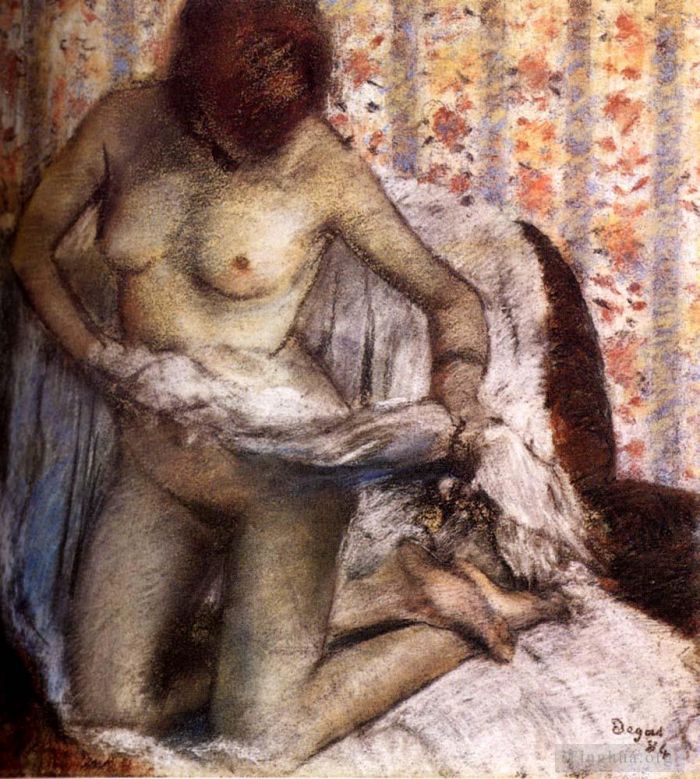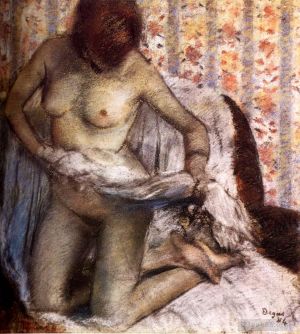After The Bath 1884
Edgar Degas
- Price: Price on Request
- Art Type: Various Paintings
- Size:
- English Comments: 0
- International Comments: 0
- Creating Date:
- Introduction and Works of Edgar Degas >>
Keywords:
Bath
Work Overview
- After the Bath
Edgar Degas
Date: 1884
Style: Impressionism
Genre: nude painting (nu)
Media: pastel, paper
Location: Hermitage Museum, Saint Petersburg, Russia
In the 1870s, Degas produced a series of brothel scenes in which his treatment of the prostitutes' bodies signalled a radical break with the idealised figures of traditional academic and classical nudes. Nevertheless, he did not make their physical appearance a straightforward record of reality.
Rather, the image of these women came from a stereotype that was widespread in the collective imagination of the time. The prostitute was seen as a fleshy creature, whose misshapen body was the result of days spent in idleness, as opposed to the work-hardened physique of the peasant girl or factory worker. It is through his attention to certain bodily details that Degas gives veracity to this series, like the pornographic photographs of the time that showed a sexually explicit aspect of the female body.
The harshness of Degas' view is not without a certain irony, directed as much towards the girls as their clients who are caught in grotesque situations of domination where they are nevertheless at a disadvantage. At times the artist even seems to reveal a certain compassion, evoking the solitude of the prostitute in her alcove.
These images remained virtually unknown during Degas' lifetime. He probably used them as a private exercise to guide his ideas on the representation of the nude body. The series consists exclusively of small monotypes, an impression on paper of a drawing previously made on a metal plate. It reveals Degas' virtuosity in framing and in conveying the atmosphere and interiors of the luxurious establishments he took as his subject.
- Copyright Statement:
All the reproduction of any forms about this work unauthorized by Singing Palette including images, texts and so on will be deemed to be violating the Copyright Laws.
To cite this webpage, please link back here.
- >> English Comments
- >> Chinese Comments
- >> French Comments
- >> German Comments
- >>Report
- The Dance Class
- Portrait of the Painter Henri Michel Levy
- The Rehearsal
- The Rape
- Edmond and Therese Morbilli
- Before the Race2
- Ballet Rehearsal
- At the Milliner s
- Singer with a glove (Café Singer)
- Head of a Young Woman
- At the Races Before the Start
- Four Dancers
- At the Milliners 2
- The Ballet Class
- The Star
- Woman Ironing 1884
- At the Races in the Countryside (A Carriage at the Races)
- Portrait after a Costume Ball Portrait of Madame DietzMonnin
- Beach Scene
- A Roman Beggar Woman
- A Carriage at the Races
- Degas in a Green Jacket
- Henri De Gas and His Neice Lucie Degas
- Dancer At The Photographers
- Ballerina and Lady with a Fan
- Self Portrait
- At the Races the Start
- At the Milliners
- Achille De Gas in the Uniform of a Cadet
- The Millinery Shop
- Interior aka The Rape
- In a Café (Glass of Absinthe or The Absinthe Drinker)
- Diego Martelli
- Cotton exchange
- Ballet at the Paris Opera
- Edmond Duranty
- The Star (Ballet or Dancer on Stage)
- Hortense Valpin
- The Dancing Class
- Dancers in Pink
- The Bellelli Family (Family Portrait)
- At the Milliners 3
- At the Races
- Cafe concert
- Portrait of Mary Cassatt
- The Parade (Race Horses in front of the Tribunes)
- Woman ironing
- Ballet Class
- Emma Dobigny
- CAFÉ CONCERT AT LES AMBASSADEURS
- The Duke and Duchess Morbilli
- The Rehearsal of the Ballet Onstage
- Dancer at the Barre circa 1880
- At the Mirror
- After the Bath
- Study of Gentile bellini 1854
- After the Bath
- Before the Rehearsal 1880
- After The Bath
- The Tub
- After The Bath 1884
- Woman Combing Her Hair
- At the Ballet
- The Dance Examination
- Woman At Her Toilet
- After the Bath Woman Drying Herself
- Seated Dancer Adjusting Her Shoes









 Singing Palette
Singing Palette